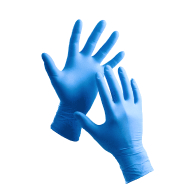CXS Tekplast Acid Resistant Gloves, Size 10
Product description
Product Features:
- Acid resistant gloves
- PVC coating
- Resistant to various substances:
— Methanol
— Sulfuric acid
— Sodium hydroxide
Technical Details:
- Refer to technical documentation for complete resistance information
Recommended application:
Working with acids and alkalis, laboratories, chemical industry, cosmetic and pharmaceutical industry
Offers enhanced forearm coverage, protecting against splashes and contaminants. Ideal for tasks requiring greater protection beyond the wrist area.
Suited for various tasks, these gloves offer essential protection and flexibility. A practical choice providing comfort and durability for everyday use.
Provides complete hand coverage, shielding fingers from hazards. Offers maximum protection and warmth, ideal for demanding tasks and environments.
Measures how far the glove extends up the arm, determining protection coverage. Longer lengths shield forearms from chemicals, heat, and other workplace hazards.
Identifies the substance applied to the glove surface that determines grip quality, protection level, chemical resistance, and durability in specific work environments.
Indicates the extent of protective coating applied to the glove, affecting grip strength, liquid resistance, durability, and task-specific dexterity.
The visual appearance that enhances workplace safety through visibility, identification, and hazard awareness while allowing for team differentiation and brand recognition.
The design of the wrist area that secures the glove and prevents debris entry. Different styles offer varying levels of adjustability, protection, and comfort.
- Chemical Resistance
- Cut Resistant
- Hand Protection
Request a free sample
Test first and buy later. Visit any product page to request your free sample.
Standards and labels
EN ISO 374-1:2016 is a standard that defines the performance requirements for gloves that protect against chemicals and microorganisms. The standard specifies the design, materials, and testing requirements for gloves to protect against chemicals and microorganisms. Possible test results include measurements of the gloves' permeation resistance, degradation, and penetration. It also includes the safety and functionality requirements for gloves.
Test results
Specified Requirements Type AEN 388:2016 is a European standard for measuring the performance of protective gloves against mechanical risks (abrasion, cut, tear, and puncture). The standard includes test methods and performance requirements for gloves to be considered compliant. Test results are reported using a series of four numbers, each representing the performance level achieved in one of the tests.
Test results
Abrasion Resistance Level 3EN 388:2016 is a European standard that provides guidelines for assessing the protection levels of gloves against mechanical risks, such as abrasion, cuts, tears, and puncture. The Abrasion Resistance Level 3 indicates a higher level of protection, signifying that the gloves can resist more intensive wear from rough materials. According to the standard, the abrasion resistance test involves rubbing the glove material against sandpaper under a specified pressure until it is worn through. Level 3 abrasion resistance requires that the gloves withstand 2000 to 7999 cycles of abrasion. This enhanced level of durability is appropriate for tasks involving more frequent or more intense contact with abrasive surfaces, such as construction work, woodworking, and handling building materials. Gloves with Level 3 abrasion resistance offer a robust barrier against wear, extending glove life and providing increased protection for the wearer’s hands, thus reducing the risk of injuries in more demanding work environments.
Tear Resistance Level 1EN 388:2016 is a European standard that outlines the testing requirements for gloves to determine their level of protection against mechanical hazards, including tear resistance. The Tear Resistance Level 1 classification signifies that the gloves offer basic protection against tearing. The test method involves applying a force to a sample of the glove material to tear it, and the force measured reflects the glove's ability to resist tearing. Level 1 tear resistance means the gloves can withstand a force of between 10 to 25 Newtons before tearing. This basic level of protection is suitable for tasks where there is a minimal risk of tearing due to light manual handling or where gloves are used to prevent scratches or minor abrasions. Gloves with Level 1 tear resistance are appropriate for general activities that do not involve handling sharp or jagged materials.
Cut Resistance, ISO 13997 Level XThe standard EN 388:2016, specifically its segment referring to ISO 13997 test, is designed to assess the cut resistance of materials used in protective gloves. A result denoted as 'Level X' means that test is not performed and the cut resistance of the product cannot be guaranteed.
Cut Resistance, Coup Test Level 1The EN 388:2016 standard is dedicated to gauging the mechanical risks for hand protection where a Cut Resistance, Coup Test Level 1 indicates minimal resistance to cutting because material achieved between 1.2 and 2.5 cycles before being cut through during the test. It means that the product tested at this level offers basic protection against shallow cuts, suitable for tasks with low risk of cut injuries. The test method used involves a rotating circular blade under a fixed force making contact with the fabric or material being tested. The blade moves back and forth across the material until a cut-through is achieved. The number of cycles required to cut through the sample at a consistent speed determines the cut resistance, with Level 1 being the second lowest rating after level 0. Products at this level are applicable in scenarios where there are minimal hazards from sharp objects, hence ideal for light duties where there is no significant risk of deep cuts.
Puncture Resistance Level 1The European standard EN 388:2016 addresses the puncture resistance of protective gloves, with puncture resistance classified from Levels 1 to 4. Specifically, a Level 1 result indicates minimal puncture resistance. This level of resistance is determined by a test involving a standardized stylus with a specified diameter and force. During the test, the stylus is pressed against the material with a force up to 20 Newtons to assess how well the glove can withstand penetration. A Level 1 rating signifies that the glove provides basic protection against small punctures or stabs, appropriate for areas with minimal risk. Practical implications for this test result suggest the gloves are suitable for light tasks where major risks of punctures are not anticipated, but are not adequate for handling sharp tools or heavy equipment where higher penetration resistance would be necessary.
EN 420:2003+A1:2009 is a European standard that sets out the general requirements for hand protection, including comfort, fit, and dexterity. Performance requirements include resistance to abrasion, cut, tear, puncture, and impact. Test results should show the gloves meet these requirements.
CE Marking is a label that shows a product meets certain safety and environmental standards set by the European Union. To get the CE Marking, a company must test and certify their product meets these standards. CE Marking is required for many products sold in the EU, including electronics, machinery, toys and medical devices. It helps ensure that products are safe for consumers and the environment, and allows for easy trade within the EU.
PPE stands for "personal protective equipment." PPE Category 3 refers to equipment that is complex and provide the highest level of protection such as powered respirators, SCBA, and full body suits. In Europe, PPE Category 3 must meet certain safety standards set by the European Union, which means that it must be designed and manufactured to protect the user without causing harm. Companies that make or sell PPE must prove that it meets these standards. They also must have a quality management system in place, have to be audited regularly by a notified body and have to have a technical documentation.
CXS delivery terms
Free delivery when you order more than 1 650,00 kr from CXS
Supplier shipping fee 60,00 kr
Brand minimum 2 000,00 kr
50,44 kr
Price per pair
50,44 kr / pair
Shipping fee is 60,00 kr for orders under 1 650,00 kr
Sold in units of one pair
Need larger quantities?
Other products you may like
Recently viewed
Need help?
Get help from our experts
Other products you may like
Similar products you may like
Recommended for you
CXS
Delivery time: 7 business days
Orders from 2 000,00 €
Supplier shipping fee 60,00 €
Free shipping on orders over 1 650,00 €



Find +150,000 products from hundreds of brands
Autonomous sourcing platform
The most efficient way to source and order supplies for your operations
Sourcing
Ordering
List products you’re looking for and we’ll find the best products and prices for you – all for free.
Need help?
Get help from our experts

